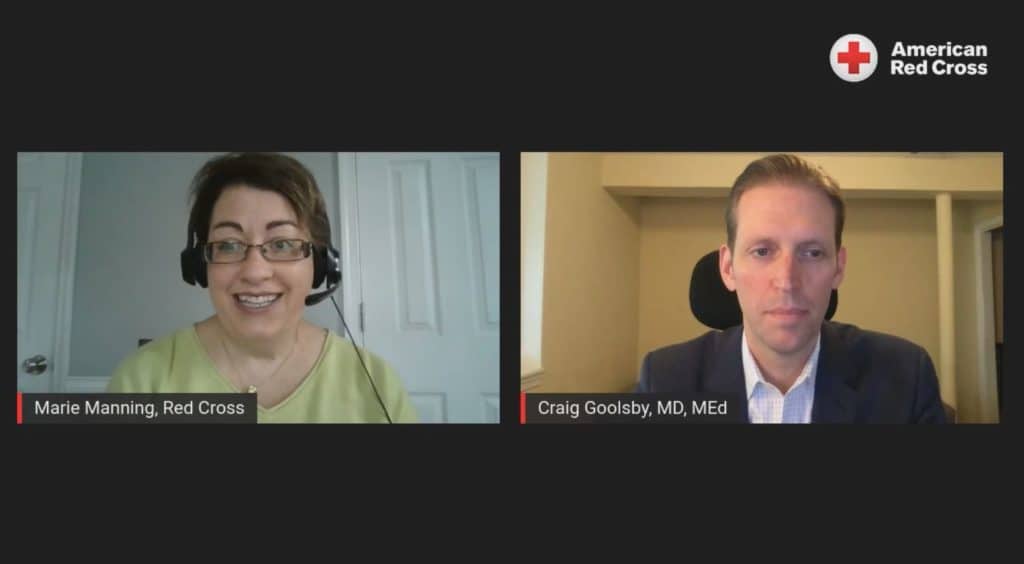
In recognition of National Preparedness Month, the American Red Cross Training Services team sat down with Dr. Craig Goolsby, a nationally recognized severe bleeding control expert, to answer common questions about severe bleeding emergencies, provide helpful first aid tips and discuss the new Red Cross First Aid for Severe Trauma™ (FAST™) course.
Dr. Goolsby is the Department of Defense Liaison to the Red Cross Scientific Advisory Council and the principal investigator at Uniformed Services University’s National Center for Disaster Medicine and Public Health, who helped support the implementation of the grant for the FAST course.
Can people who aren’t medical professionals really help during severe bleeding emergencies?
“I went twice to Iraq as a medical director for a really busy emergency department. I was amazed by the patients we saw who were severely injured but who made it to us alive. The difference between Iraq and the United States was that the military had put together a program to teach soldiers what to do in the event of life-threatening bleeding and equipped them with very simple, easy-to-use equipment that was lifesaving at the point of injury. The soldiers around them could take action that was lifesaving even before a medical person or ambulance could get to them.”
What are the steps you should take if you see an accident with severe bleeding?
“The Red Cross recommends “check, call, care.”
Check: Make sure the scene is safe. When there is life-threatening bleeding, there could be other unsafe conditions such as glass or fire. We don’t want others to get hurt.
Call: Call 9-1-1 and get the ambulance rolling because we know it’s going to take a few minutes to get there.
Care: Stop the bleeding to the ability you can, whether it’s applying direct pressure or using a tourniquet.”
How much time do you have to respond to severe bleeding?
“We really want people to take immediate action. There are a few minutes before an ambulance arrives and what you do in those few minutes will help somebody. Start treating people. If you don’t have a tourniquet yet, you can mimic the course video, where Alex takes her hoodie and places pressure on the wound. If the pressure doesn’t stop the bleeding, it will at least slow it, which will be helpful to that person.”
What do you do if you don’t have a tourniquet? Can you use a belt or a scarf?
“We get this question quite a bit. The short answer is the best thing to do if you don’t have a tourniquet is to use direct pressure. In fact, the STOP THE BLEED logo is just a hand up. The reason we selected that logo is because you can save a life just by pushing on a wound with your hands. In general, a belt or scarf is unlikely to work. For most circumstances, if you don’t have the right tool, we’d prefer you do the best thing at that point which is apply direct pressure. I’d avoid very narrow things like shoelaces, which can be very damaging and will be unlikely to stop the bleeding.”
Why do people in the FAST course repeat everything back to each other?
“In the FAST course, you will learn how to use closed-loop communications, which is a way of effectively communicating in high stress environments. For example, if we were in a high stress environment, we’d be very purposeful about using each other’s names. Instead of saying “go get a bleeding control kit,” I would say, “Marie, go get the bleeding control kit” and you would respond back to me, “Okay Craig, I’m going to get the bleeding control kit.” Then when you return, you’d let me know you had it. There’s a lot of things that need to be done on a scene with a bleeding emergency and talking this way keeps people doing the things they need to do and avoids everyone going to do the same thing.
What makes the FAST course special?
“The program was an opportunity to take what I saw happening on the battlefield and put it into an education program that is really lifesaving. FAST is a way we can empower young people across the country. We also got a lot of support from HOSA-Future Health Professionals in promoting this program to high school students and teachers with a special interest in healthcare. FAST teaches valuable lessons and it can be done at no cost thanks to the grant program that was laid out by the Department of Homeland Security Science and Technology Directorate.”
Find more first aid tips and the full live discussion with Dr. Goolsby on the American Red Cross Training Services LinkedIn page here.
